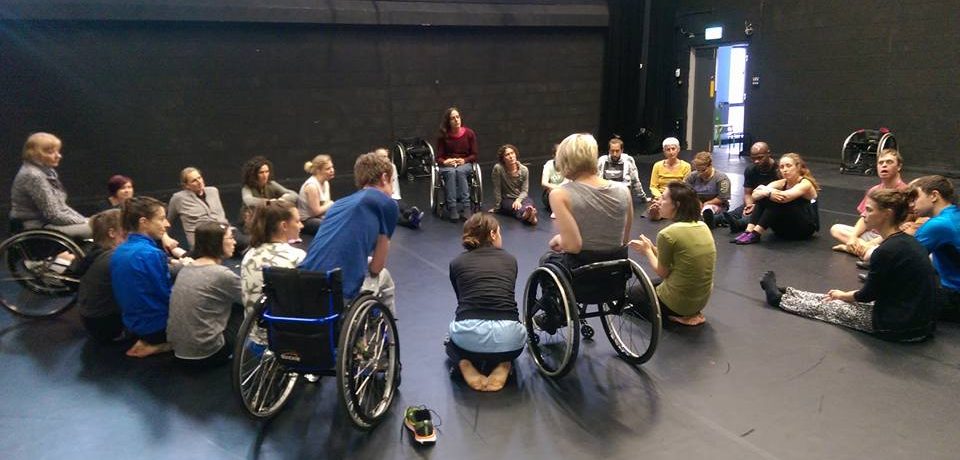
Working with a Score
TARGET GROUP
Adults with limited mobilityPARTICIPANTS
18-22DURATION
2:20 hoursORGANIZATION
Stopgap Dance CompanyGoal - Essential question
This lesson aims to inspire creativity, to empower and to get the participants to work in a group.
Focus/ Interaction (20 minutes)
Using the z-health score (right/left/centre) get participants to come up with one movement to the right, one to the left and one in the centre. Then as a group slowly follow the score.
Progression: gradually introduce a tempo and/or work with the score in pairs, alternating with each box.
Outcomes: Ice breaker, concentration.
Butoh/Control over the body/ Visualization (20 minutes)
Show the image of a straight declining line that has a small plateau at the top and the bottom, the movement that corresponds to this image is as follows. Begin in an upright position, over the course of a minute move to the lowest position possible, encourage awareness of where the movement begins and where it ends and promote a sense of melting. If they are interested talk about Butoh practice and images that might help.
Progression: lengthen the amount of time it takes to move from an upright to a low position, do the reverse (the symbol is the same but an incline instead of a decline).
Outcomes: Moving from an upright to a lower position.
—
Butoh (舞踏 Butō) is a form of Japanese dance theatre that encompasses a diverse range of activities, techniques and motivations for dance, performance, or movement.
Group/ Spatial Awareness (20 minutes)
Again look at the corresponding symbols first. These are in boxes that always have a set front (a mark on the box dictates this), arrows show direction and length of travel and flat lines hugging the edge of the box communicate facings. Simply put a small score of different instructions together that they must follow as a group, aiming to move onto the next instruction at the same time.
Progression: increase the amount of instructions (length of score), maybe add in a quality or intention to each instruction.
Outcomes: Travelling, direction and facing.
Exploring range of movement/Accumulation (20 minutes)
The symbols look like a half open book sitting on its spine and a closed book sitting upright on the spine, the open book giving the instruction to open the body and the closed book the instruction to close the body. Create a simple open and close accumulation exercise that offers choices but encourages the movement to happen on a particular side of the body (right, left, front or back).
Progression: use more complicated versions of the symbols, for example, the image upside down directs the movement to come from a low point on the body, the original version of the symbol can then instigate movement in the upper most regions of the body. Changing the size of the symbol directly influences the movement and you could introduce letters to indicate the side of the body that should be used (r=right, l=left, f=front, b=back).
Outcomes: Opening and closing exercise.
Improvisation (20 minutes)
Individually begin by drawing focus to different parts of the body by looking at them, then look at the space and people in it. Reverse this so without looking at the body draw focus to it, maybe imagine that you are being looked at by a camera, or by moving parts of the body you bring focus to them.
Progression: wink murder (game)
Outcomes: focus experience
Body Awareness/Contact (20 minutes)
After having some time to focus on the breath, working to lengthen the inhalation and exhalation, encourage each inhale and exhale to resonate deeper in the body, maybe initiating movement. Then as a group try and create a giant lung, moving with every inhale and exhale, having con-tact where possible. The symbol for breathing out could be a convex shape and the symbol for breathing in a concave shape.
Progression: try inhaling and exhaling in canon and work at finding movement right out in the extremities of the body that coordinates with the breath.
Outcomes: breath work
Choreography (20 minutes)
Using the symbols put together a score, slowly as a group (company) work through the score.
Progression: again, as a group work through a score but this time everyone has input as to what the score may be. You could place the symbols around the space if some participants are non-verbal, that way they can move towards the instruction/symbol they want to use. Or if you have time create symbol
boards. If the participants are confident put them in smaller groups and get them to choreograph (create scores) on each other.
Outcomes: Using the score to influence movement making.
